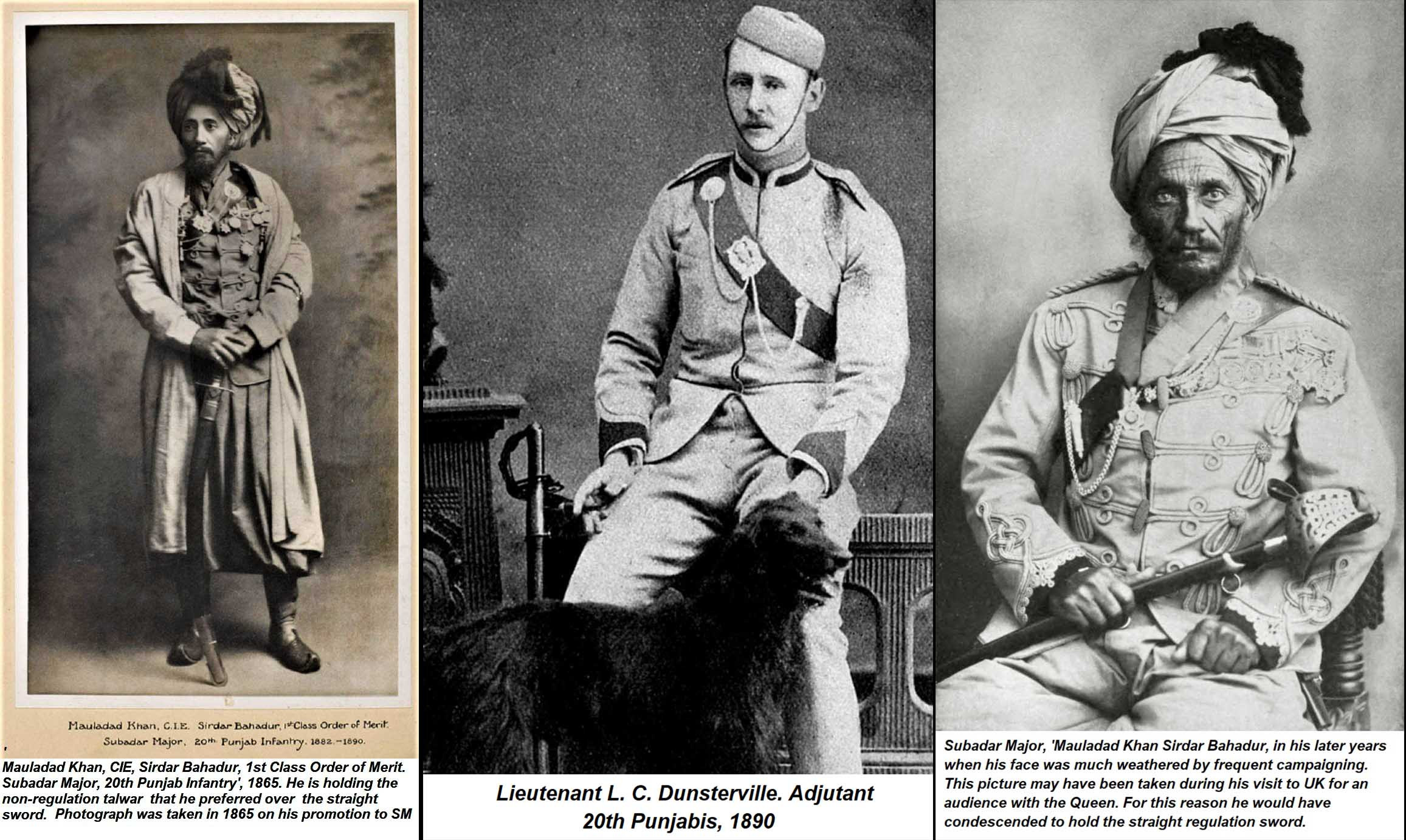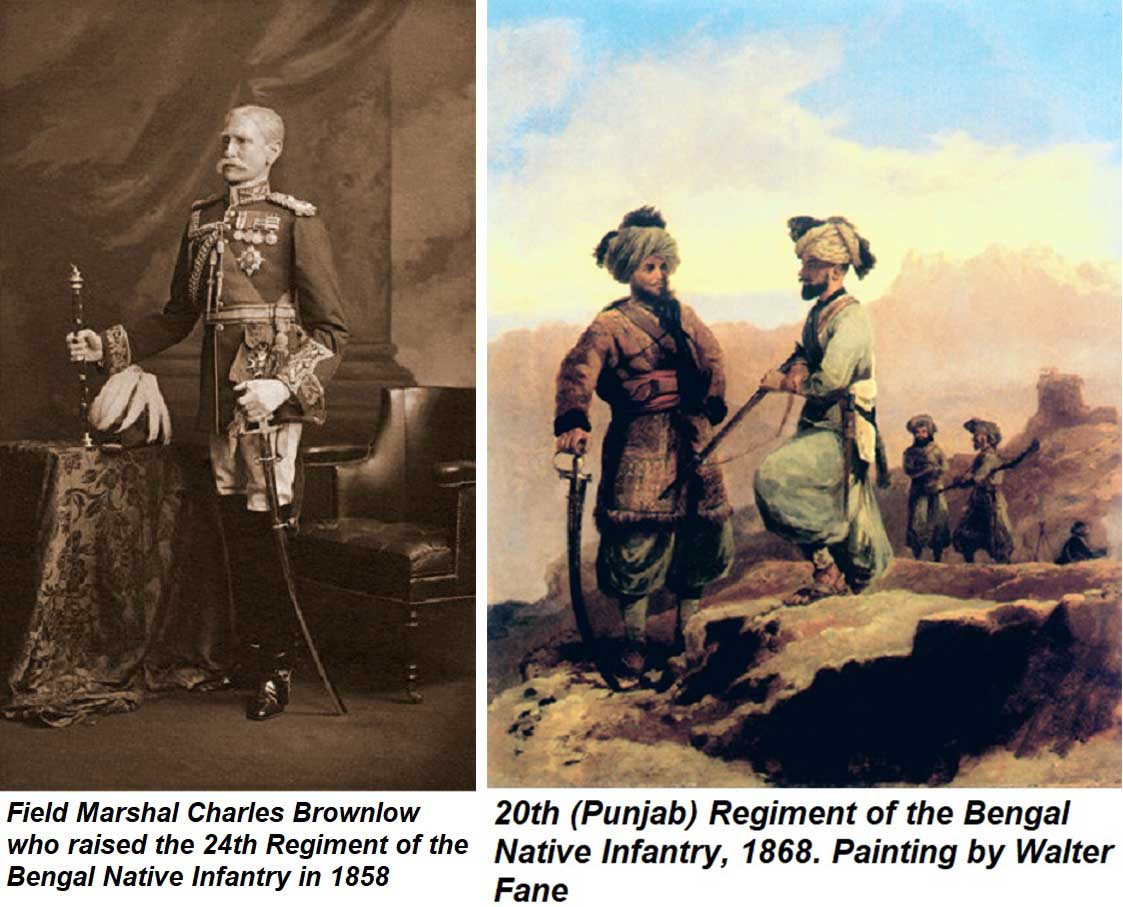The 6th Battalion of the Punjab Regiment is one of the oldest units of the Pakistan Army. It was raised in 1858 by Captain Brownlow as the 24th Regiment of Bengal Native Infantry (BNI). During the Indian Army Reforms of 1904, it was renumbered as the 20th (Duke of Cambridge's Own) (Punjab) Regiment of Bengal Native Infantry (Brownlow's Punjabis). In the reorganisation of the army in 1922, it became the second battalion of the 14th Punjab Regiment comprising 2/14th Punjabis.
One of the central figures in any battalion is a subedar major, and being an old battalion, 6th Punjab had its share of those who could be considered remarkable. Prior to the First World War, subedar majors were nearly always old men who had been in the regiment before their present colonels had joined as lieutenants. They were full of wisdom and possessed great influence. However, Subedar Major Mauladad Khan (1822-1890), a Kuki Khel Afridi, who had joined the 24th BNI on its raising, was quite unique.
Khan had seen a great deal of service and wore medals for the revolt of 1857, Afghanistan 1881, and Egypt 1882, with a clasp for the battle of Tel-el-Kabir, and the N W Frontier medal with many clasps. Khan was considered as brave as a lion and held the prestigious Indian Order of Merit, which had been instituted in 1837 by the East India Company as an award for outstanding gallantry to native members of its forces. He was given the title of Sardar Bahadur and the Companion of the Indian Empire, which in those early days was a particular honour, but he did not appreciate it. He explained that there was some sense in the Order of Merit, and in the Sirdar Bahadur, since a money allowance was attached to them, but the C.I.E. was quite beyond his comprehension, and he considered it a very barren honour.
Major-General L C Dunsterville had been associated with Khan when he was serving as the adjutant of the 20th Punjabis. Dunsterville was commissioned into the British Army in the Sussex Regiment in 1884. The battalion was subsequently posted from the UK to India. Its first station was Rawalpindi where Dunsterville enjoyed the social life and the winter. In 1887, he decided to transfer to the Indian Army because he could not afford to serve in a British battalion and was posted to the Mian Mir Cantonment in Lahore. He was a very intelligent and hardworking officer and in three years had learned Urdu, Punjabi, Pushto and Persian and made himself familiar with the major religions of the subcontinent. In 1887, he joined the 20th Punjabis as an adjutant back in Rawalpindi. His autobiography has a tale about Mauladad in a vein of comedy.

Duties of a conscientious adjutant were always absorbing and difficult, but Dunsterville found his position exceptionally challenging. Like many of the old Frontier regiments, the 20th Punjabis had retained a great deal of irregularity, particularly in its uniform. The test for the dress of a battalion was the Guard Mounting, and on his first day of inspecting the guard, he saw that there was a great variety in the manner in which the turbans were tied. He had learned that Sikhs, Dogras, and Pathans all had their particular way of arranging their head-dress but then he noticed that some of the fringes were black, some blue, and some green, some composed of long strings, some of little cotton balls. There was more fantasy in the footgear!
One man had plain leather sandals; the next one had a good blunt-toed Punjabi shoe; one wore a pair of ornamental sandals with gold thread and silk tassels; and another one was wearing light Punjabi shoes, with thin ornamental points extending some inches beyond the toe. There is a certain charm about minor irregularities in the dress, and that seems to have a fascination for soldiers, but the adjutant was determined to set things right as soon as possible.
The chief obstacle to making an improvement in the regularity of dress was the Subedar Major Mauladad Khan. He was a fine old soldier with a noble war record and not much education but like all subedar majors, an ultra-conservative. He was a veteran of the old school, who could never be brought to believe that there could be anything good in a new way of doing things, and whose invariable reply to the suggestions by the adjutant was: “This is the custom of the regiment. What you suggest has never been done.”
Khan explained his way of doing it “as we used to do in Talagang.” Twenty-five years ago, the regiment had been stationed at a small place in Punjab called Talagang, and it seemed that most of the regimental customs had been created during that period. Dunsterville came to hate the sound of the word Talagang. Whatever changes he suggested in any regimental matter with a view to introducing a little regularity were always opposed because “it had not been done in Talagang.” The colonel was almost as bad as the subedar-major. When the adjutant would put any matter up to him, he would send for Mauladad Khan and ask him, “How did we do it in Talagang?”
After the Egyptian Campaign of 1882, Mauladad Khan had the honour of visiting England as the guest of Queen Victoria, there being at that time no such thing as the appointment of an orderly officer to the Sovereign. Queen Victoria always took a deep interest in her Indian subjects, and for that purpose had undertaken the study of Urdu. However, Khan was completely illiterate, and his knowledge of that language was very limited and barely sufficed for any subject beyond military duties. He probably tested the patience of Her Majesty during the interview. He was taken to see the sights of London but took little interest in them. His memories chiefly consisted of admiration for the greenness of the fields compared with the barren hills of the Khyber, and the magnificence of horses and cattle.
Since Khan was more irregular in every way than any man in the regiment, it could be well understood how great an obstacle he was to the adjutant’s efforts toward regularity. He wore his turban as he pleased and had a habit of taking it off at most solemn moments to scratch his head. In place of a regulation sword, he carried an old talwar, curved like a crescent moon. He did not appreciate the solemnity of a ceremonial parade in which he could see no sense, and his attempts to salute with his talwar in the march-past consisted of a friendly wave and a shake of the blade in the direction of the inspecting officer. When the latter took exception to such a peculiar deviation from the proper salute, it had to be explained to him that “it was only Mauladad.”. Nothing more was said.

Dunsterville did succeed in curing Khan of one of his peculiarities—wearing of a coloured handkerchief protruding from the inside of the collar of his tunic and fluttering around his neck, but he only gave in to the adjutant out of pure friendship. In plain clothes Khan was hopeless. No one could recognize in the peculiar jumble of odd garments he wore as a distinguished native officer of Her Majesty’s Indian Army. Dunsterville spoke tactfully to him about that but to no purpose. It only made Khan laugh, and he related an amusing adventure that befell him.
Khan was going home on leave, and on his way to the Khyber Pass, the tum-tum (horse carriage) broke down and he continued on foot. It was a very hot summer afternoon, and he came upon a sahib lying in the shade of a tree. Sahib seemed to be ill, and Khan gave him some water and helped him to his feet. Sahib was very grateful and attempted to give a baksheesh of four annas. He evidently thought Khan was one of the men employed for road repair. Khan returned the four annas telling him who he was and that he had plenty of money, but the sahib did not seem to believe him.
Mauladad Khan had the heartiest contempt for all “red books”, the name he had coined for military regulations. He was continually giving punishments he had no power to give, in utter defiance of the Indian Articles of War. On visiting the Quarter Guard, Dunsterville often found a man imprisoned on the order of Mauladad; often no one knew what for, and when the adjutant spoke to Mauladad about it, he did not seem quite sure himself.
One morning the colonel asked Dunsterville how many men were on duty in the Quarter Guard and was told that there were twenty-one. The next day the colonel who was very conscientious and a bit fussy ticked off his adjutant. “You don’t know much about your work”, he scolded. “You don’t even know how many men you have on duty. I visited the Quarter Guard and found twenty-four men.” This was an unpleasant rebuff for Dunsterville who knew he had been right. So, he set to work to inquire and found that it was Khan again. “Yes,” said the Subedar Major. “It was a dark and stormy night, so I put an extra sentry on the back of the Magazine.’ A very wise precaution, of course, but quite beyond his powers, and making things rather difficult for Dunsterville.
Up to 1882, Khan knew the drill movements quite well. Anything beyond that he refused to learn, regarding any change as mere foolishness. When a pamphlet was issued on new formations and movements, the second-in-command gave a lecture to the Indian officers on the subject, which was very thoroughly done in a most painstaking way, with the aid of diagrams skilfully drawn on a blackboard. However, at the conclusion of the lecture, Khan had to have his turn and summed up the whole affair: “You’ve all heard what the Major says, and you must try to remember all these new changes. What they are all about I don’t know, but it is God’s will that they have to change. But they are really of no importance at all. In the attack, there is only one thing to remember, and that is ‘fix bayonets and charge’.”
Fix bayonets and charge was Khan’s advice on all occasions. During an inspection, a general asked him what he would do if during an advance he suddenly found a body of the enemy on his right flank. His reply was, “Fix bayonets and charge.” “Very good,” said the general, “and if it seemed to you that the enemy entirely outnumbered you, what then?” “Fix bayonets and charge,” Khan replied without hesitation. The general did not ask him any more questions, but turning to the colonel he said, “That seems to be his solution to every problem, and I will not say anything to damp his ardour. I believe if I asked him what he would do if I dared to disagree with him, he would reply ‘fix bayonets and charge’.”
In 1888, Mauladad Khan retired on a very handsome pension. A year or two later, the old hero died. His place was immediately taken by an equally unprogressive subedar major. Dunsterville did not have the power to resist anymore and admitted that the spirit of the regiment of Talagang had conquered him, making him as bad as the rest.
References:
History of the 20th (Duke of Cambridge's Own) Infantry, Brownlow's Punjabis. Swiss and Co. 1909
Excerpt from Stalky's Reminiscences by Major-General L.C Dunsterville
Syed Ali Hamid is a retired Pakistan Army major general and a military historian. He can be contacted at syedali4955@gmail.com. All facts and information is the responsibility of the writer
